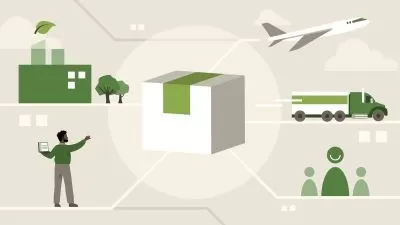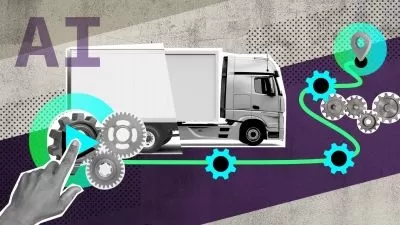Supply chain logistics
e3 Business
5:01:05
Description
you will understand All tasks necessary to get the right product in the right quantity and right condition
What You'll Learn?
- Logistics Goals & strategies
- Objectives of Logistics
- Importance of Logistics
- Increased Use of Technology
Who is this for?
What You Need to Know?
More details
DescriptionThrough this course, you will understand All tasks necessary to get the right product in the right quantity and right condition at the right place at the right time for the right customer at the right price.
Supply Chain Logistics is a field that focuses on the planning, coordination, and execution of the movement of goods and information throughout the supply chain. This involves managing the flow of products, services, and data from the point of origin to the point of consumption, while optimizing efficiency, cost-effectiveness, and customer satisfaction.
In a Supply Chain Logistics course, participants gain a comprehensive understanding of the key principles, strategies, and best practices involved in managing logistics operations within a supply chain. The course covers a range of topics, including transportation management, inventory control, warehousing, demand forecasting, order fulfillment, and customer service.
Participants learn about various transportation modes and their characteristics, logistics network design, routing and scheduling, freight consolidation, and last-mile delivery. They explore inventory management techniques such as demand planning, safety stock calculation, order quantity optimization, and just-in-time (JIT) inventory. Effective warehouse management, including layout design, storage methods, picking and packing strategies, and the use of technology like warehouse management systems (WMS), is also emphasized.
The course delves into demand forecasting methods and their application to improve supply chain planning and inventory management. Participants gain insights into customer order management, order processing, order prioritization, and the fulfillment process to ensure timely and accurate delivery to customers. The course also highlights the importance of customer service in logistics, focusing on strategies to enhance customer satisfaction and loyalty.
Additionally, Supply Chain Logistics courses often cover topics related to supply chain sustainability, risk management, and emerging trends such as e-commerce logistics and omni-channel distribution. Participants learn about supply chain analytics and the use of data-driven approaches to optimize logistics operations and make informed decisions.
By completing a Supply Chain Logistics course, participants acquire the knowledge and skills necessary to effectively manage logistics operations within a supply chain. They develop expertise in optimizing transportation, inventory, and warehousing activities to reduce costs, improve efficiency, enhance customer service, and mitigate risks. This knowledge can be applied across various industries and organizations, enabling professionals to contribute to the success of supply chain operations in today's complex and dynamic business environment.
Who this course is for:
- Managers
- Supply Chain Managers
- Business Owners
- Entrepreneurs
Through this course, you will understand All tasks necessary to get the right product in the right quantity and right condition at the right place at the right time for the right customer at the right price.
Supply Chain Logistics is a field that focuses on the planning, coordination, and execution of the movement of goods and information throughout the supply chain. This involves managing the flow of products, services, and data from the point of origin to the point of consumption, while optimizing efficiency, cost-effectiveness, and customer satisfaction.
In a Supply Chain Logistics course, participants gain a comprehensive understanding of the key principles, strategies, and best practices involved in managing logistics operations within a supply chain. The course covers a range of topics, including transportation management, inventory control, warehousing, demand forecasting, order fulfillment, and customer service.
Participants learn about various transportation modes and their characteristics, logistics network design, routing and scheduling, freight consolidation, and last-mile delivery. They explore inventory management techniques such as demand planning, safety stock calculation, order quantity optimization, and just-in-time (JIT) inventory. Effective warehouse management, including layout design, storage methods, picking and packing strategies, and the use of technology like warehouse management systems (WMS), is also emphasized.
The course delves into demand forecasting methods and their application to improve supply chain planning and inventory management. Participants gain insights into customer order management, order processing, order prioritization, and the fulfillment process to ensure timely and accurate delivery to customers. The course also highlights the importance of customer service in logistics, focusing on strategies to enhance customer satisfaction and loyalty.
Additionally, Supply Chain Logistics courses often cover topics related to supply chain sustainability, risk management, and emerging trends such as e-commerce logistics and omni-channel distribution. Participants learn about supply chain analytics and the use of data-driven approaches to optimize logistics operations and make informed decisions.
By completing a Supply Chain Logistics course, participants acquire the knowledge and skills necessary to effectively manage logistics operations within a supply chain. They develop expertise in optimizing transportation, inventory, and warehousing activities to reduce costs, improve efficiency, enhance customer service, and mitigate risks. This knowledge can be applied across various industries and organizations, enabling professionals to contribute to the success of supply chain operations in today's complex and dynamic business environment.
Who this course is for:
- Managers
- Supply Chain Managers
- Business Owners
- Entrepreneurs
User Reviews
Rating
e3 Business
Instructor's Courses
Udemy
View courses Udemy- language english
- Training sessions 45
- duration 5:01:05
- Release Date 2023/10/28















